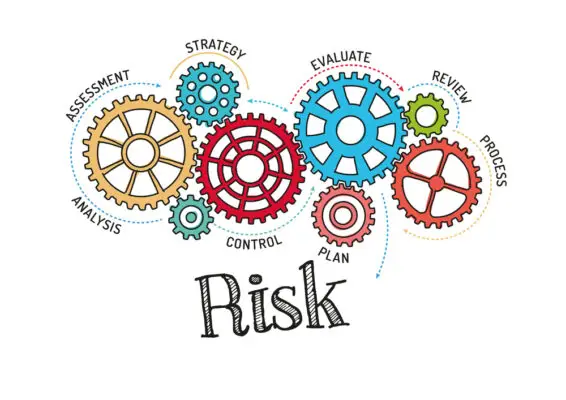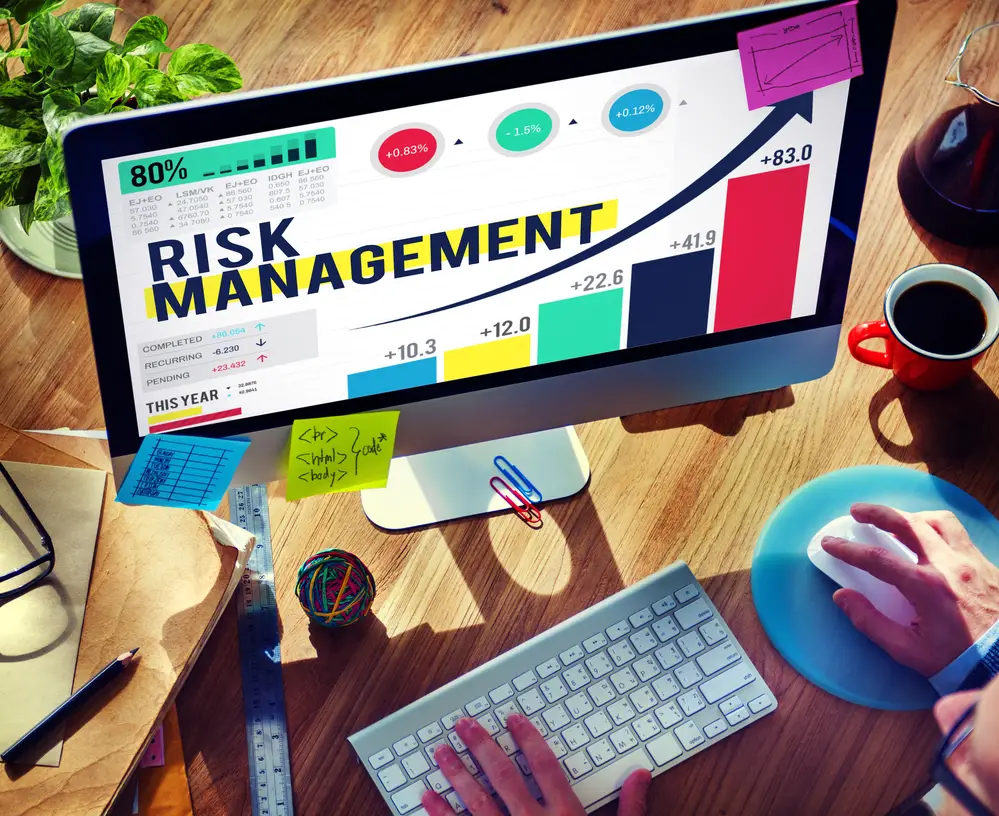Managing risk is essential for organizations. While the risk management process may seem daunting, five essential steps are important in the manual risk management process. Here are the five essential steps for effective risk management:
1) Identify the risks. This step is all about brainstorming and inventorying everything that could go wrong. Once you’ve identified the risks, you can begin to assess which ones are most likely to occur and which ones would have the biggest impact if they did occur.
Identifying risks in a risk register enables the creation of a risk ongoing database. It can be done with the oversight of the risk manager and risk management team. A risk management solution can also record identified risks.
2) Analyze the risks.<span< a=””> style=”font-weight: 400;”> Once you’ve identified the risks, it’s time to start analyzing them. This step involves looking at factors such as the probability of a particular </span<>enterprise risk occurring and the potential impact it could have if it did occur. You can prioritize which must be addressed first through analysis and risk evaluation.
3) Develop a plan to manage the risks. This step is about developing a strategy for dealing with each identified risk. The plan should include contingencies for what to do if a particular risk does occur. Organizations will be better prepared to deal with potential problems through a risk management plan.
4) Implement the plan. This step involves implementing the plan and ensuring everyone knows all the identified risks. Implementation often requires changes to policies and procedures and training for employees on properly executing the plan.
5) Monitor and adjust the plan as needed. This final step is periodically reviewing the risk treatment plan to see if it’s still effective and making any necessary adjustments. As new risks arise or old ones change, it’s important to update the plan to continue to be an effective tool for managing risk.
Organizational upper management manages risk every day through business operations. The risk management process is an important part of every enterprise and focuses on protecting every single piece of information in the company.
Moreover, a report enumerates that a company’s most valuable areas of risk management were the improvement of the quality, availability, and speedy data at 73.8% and the improvement of the risk management software systems and technology at 68%.
Risk management is often considered one of the most important aspects of any business or organization. However, many people don’t really understand what it is or how it works. This blog post will discuss the five essential risk management steps that all organizations should know.
We’ll also provide tips on getting started with risk management in your own organization. So, whether you’re a business owner, manager, or employee, read on for some valuable information!

What are Risk Management Standards?
A risk management standard is a strategic sequence involving the organization’s objectives and aspirations. The plan will identify risks and encourage mitigation using the best practices.
The standard is generally formulated and developed through various agencies collaborating on common objectives that help further assure the organization’s effective risk management processes.
Standard risk management standards are guidelines to ensure risk management takes shape and structure. The standard usually includes checks or examples that help companies comply with their obligations. Risk Management Standards have many different forms.
The Risk and Insurance Management Company’s Risk Maturity Model (RMM)
A risk assessment tool is provided to assess seven fundamental attributes of any risk management plan on a scale from minimal to leading.
Risk management is a core aspect of any business or project, pivotal in safeguarding against potential threats, whether financial, strategic, operational, or risks induced by natural disasters.
An effective risk management program begins with risk identification, which encompasses recognizing and understanding categories of risks such as human error, external risks, and even less tangible risks. A business risk profile is developed from this process, cataloging potential threats to the company’s business activities.
The International Organization for Standardization, or ISO, has codified a set of risk management standards, specifically the ISO 31000:2018 – Risk Management, guiding organizations towards the application and benefits of effective risk management.
Implementing these guidelines is often the responsibility of the chief risk officer, whose characteristics ideally align with the challenge of overseeing a complex task.
Within this process, the severity of the loss or potential severity of an impact plays a significant role in prioritising and addressing risks. Whether it’s through a Duty of Care Risk Analysis, a Customs Risk Management Framework, or Taxonomy-based risk identification, understanding the potential loss from unwanted events like medical errors or legal liability aids in the development of action plans.
In particular, contingency planning and business continuity are vital aspects of the risk management process. From dealing with catastrophic events like climate events, to mitigating risks in aerospace projects, every detail can be crucial.
Sentinel events, for instance, can prompt an evaluation of the current risk control measures in place, while measures like anonymous risk reporting channels can further bolster risk management efforts.
Mitigation of risks often involves risk transfer to insurance companies, providing a safety net against the risk of loss. The insurance industry has long been a key player in risk management, with various solutions tailored to address various risks.
Publications like Business Insurance Magazine offer insight into this ever-evolving field.
Furthermore, the cost-benefit analysis of risk management decisions is important. Factors such as the average cost, cost accrual ratio, and potential gain from positive risk all come into play.
This highlights the importance of having an operational risk management plan that aligns with the organization’s financial capabilities.
One notable development is the use of Enterprise Risk Management (ERM) which includes risk management techniques for handling risks on a company-wide scale.
ERM involves coordinating with project teams, considering the risk management measures of different departments, and integrating them into a comprehensive approach to managing all risks.
Risk management is a dynamic field that involves everything from climate change adaptation planning to asset liability management.
As the world continues to evolve, so too will the methods and tools for managing risk. Ensuring your organization is prepared to handle potential risks and has the tools to respond effectively is key to a secure and prosperous future.
Risk management evaluations are designed to give businesses an overview of international standards and demonstrate how well they meet their risk management strategy requirements. The company receives maturity ratings with practical suggestions on increasing its programs and gaining numerous benefits from maturity.
ISO 31000:2018
ISO 311000 has been issued since 2009, with a review in 2018. The standard describes risk identification, assessment, prioritization, and mitigation steps. The Framework emphasizes ERM as outlined in the new standard for 2018.
Risk management is a critical function that can have far-reaching effects on an organization’s strategic and financial risks. Risk management involves identifying and assessing these risks and developing an approach to mitigate their potential impacts. This can encompass anything from operational to intangible risks that can be more difficult to quantify.
ISO 31000:2018 – Risk Management provides a robust framework for applying risk management. Following these guidelines can yield numerous benefits, including reducing adverse events and minimizing the severity of losses. One key aspect of this standard is the concept of tolerable risk. This refers to the level of risk deemed acceptable by an organization, which is used to guide mitigation strategies.
One important step in the risk management process is threat assessment. This involves analyzing potential risks and determining their potential severity and impact. An example of a formula that can be used in this context is Accident × Severity, which provides a quantitative measure of risk.
The communication of risk is also a crucial element of risk management. Whether it’s food safety risk communication or crisis and emergency risk communication, clearly conveying information about risks can help mitigate their impacts and prevent incidents. This is where the characteristic of an effective risk officer becomes paramount – excellent communication skills are a must in this role.
In addition to managing traditional forms of risk, organizations increasingly have to consider more intangible forms. These can range from reputation damage to the risk associated with new technologies. Successfully managing these risks often requires a more sophisticated approach and understanding of their unique challenges.
Finally, it’s important to remember that risk management isn’t a one-time activity. It’s a continuous process that must be integrated into an organization’s day-to-day activities. By constantly monitoring risks and adjusting strategies, organizations can effectively manage their risk profiles and ensure they’re prepared for their challenges.
You can download the standard from the ISO website https://www.iso.org/standard/65694.html.
British Standard (BS) 31100
The Code was issued in 2011, providing guidelines for applying ISO 31000 Principles to risks, including determining, assessing, resolving, reporting, or reviewing.
Risk Assessment
Risk assessment can be qualitative and quantitative. An analysis of qualitative criticality measures event probability and effect. A quantitative evaluation analyses the financial impacts of an event. Both are required to evaluate the risks and opportunities.
Risk management in any organization, whether strategic risks or operational, is vital to business stability and growth.
This process and the benefits of risk management involve various steps, from identifying the negative risks that could impact the business to analyzing the severity of their potential loss and impact. A vital step in this process is determining the tolerable level of risk an organization is willing to accept while striving towards its objectives.
A strategic approach of strategy risks to risk management is crucial in effectively navigating these risks. Organizations can establish an ideal risk management framework by following the guidelines of ISO 31000:2018, a globally recognized risk management standard.
Depending on the characteristic of risk officer, application of management applying these guidelines can lead to numerous benefits, including reduced uncertainty and enhanced operational effectiveness.
Moreover, risk management is not limited to just tangible risks. Intangible risk management is equally crucial, particularly in this era of digital revolution and increased global connectivity. These risks, from reputational damage to data breaches, require a nuanced and robust management strategy.
Being a successful risk officer is about having the ability to foresee and manage both these tangible and intangible risks effectively.
Equipped with these skills, they can aid in the development of a global disaster plan, incorporating the latest risk management strategies as well as lessons from past incidents such as those highlighted by Douglas Hubbard in “The Failure of Risk Management: Why It’s Broken and How to Fix It” (2009).
Moreover, the effective management of risk extends to areas like food safety. Given the potential health and safety implications, the activities involved in ensuring food safety often necessitate their unique risk management approach.
Ultimately, an effective risk management process is all about creating a resilient organization that can navigate the myriad of risks it faces in today’s complex business landscape.
Risk assessment covers risk identification, analysis, and evaluation activities in the risk management process.

Qualitative assessment
Each identified risk and opportunity is classified according to the criticality scale of the project and will be prioritized. Evaluating the event probability is usually measured preferably through experience, by the progress of the project, or otherwise by talking to one of the experts in the field.
If, for example, there was a 50% probability of a manufacturer’s failure to perform research on a modification Y before 2025, it could be the highest priority risk of the organization.
Quantitative assessment
In most projects, the quantitative evaluation aims to establish a financial evaluation of the impact of risk on opportunities and its potential impact if they happen. Depending upon the organizational setting of the company, the risk owners and project managers can undertake this task.
These amounts constitute an additional cost not anticipated in a project budget. In this sense, this step will be necessary to calculate the need to add extra funds to cover risks and opportunities for a project.
5 Essential Steps of the Risk Management Process
Identification of risks
To begin the whole process, the risk management process identifies everything that could affect your business negatively. Depending on how many risk factors you’re putting on your list – or at a given point in your life – expect to have a few more days of risk.
Ask your colleagues for their risk assessments. The aim of the plan is the most comprehensive. Give yourself time to identify the potential risks unless you get stuck in analytical parity or cannot move on to other tasks simultaneously. This process is ongoing, and you may add more risks over the next few years.
To manage risk, an organization must first identify what types of risk they have faced or risk exposure and how that risk could be handled. There are several types of risks, including; market and operational risks.
Risk is usually noted manually in a risk matrix; the risk identification process is much simpler. There are various risk identifications like interviews, brainstorming, and questionnaires.
Risk Management Evaluation
Any organization looking to improve the effectiveness of its risk management should look at risk assessment techniques. Evaluation helps companies understand themselves and their strengths and vulnerabilities.
More evaluations help businesses better understand the risks they face in their business processes. This evaluation may take time manually, and risk management solutions can simplify the review and assessment process. It’s important to do a review before changing the risk management framework.
Risk needs classification by priority. Most risk management software has several categories according to risk severity. The risk of inconvenience or loss is low, while those causing catastrophic loss are the worst.
It is critical for a company to rank the risks because this gives them broader visibility into risks within the company. The business could face some small risks but might not require management intervention. Similarly, only one high-risk threat should have been immediately dealt with.
After a complete risk analysis, the risk is classified by severity and prioritized. Often companies use risk management products to categorize their risks according to the severity and various risk factors.
Risks that may have minor inconveniences to an organization are rated as low risk, while risks that may affect their operations are considered high risk. The risk is not necessarily required to be acted upon by a higher executive, but high risk requires immediate action.
Risk Treatment
To manage the risk, an organization must establish the best strategy to achieve that goal by developing an appropriate management plan.
A risk management plan has been developed to minimize the likelihood of a risk occurring or mitigate the risk. In a situation where an opportunity has been created, treatment plans aim to improve the opportunity’s chances. A response strategy will be developed depending on the risks or opportunities posed.
Monitor your risks
Maintain a record of the Risk mitigation results for a specific or past project. Your company must start a fresh process when implementing risk management strategies is impossible. Avoid impulsivity or a firefight to solve any issue. In fact, if we focus on reducing risks and opportunities for project risks, a calm perspective can help, and the project’s potential risks will be mitigated.
Risk response strategies
The risk owner must follow up with the treatment plan progress. They must regularly report to a Risk Director. This is required to maintain current risk records. Costs associated with risk management must be included in the project budget.
When does risk become an issue?
Despite measures to reduce risk, death or injury could rise. When risks have been confirmed, the risk can be viewed not as a risk but rather as a problem. Risk managers then notify project stakeholders and transfer the risk that became a problem into the issue log.
Importance of Risk Management Process
Catastrophic losses
Management of risks has profound monetary effects. It wouldn’t be more profitable if I didn’t protect my business. You may have a market loss simply because your predictions did not reflect changes in the market.
You’ll have losses if you don’t know what’s involved in growing your company. A failure to manage difficult situations can damage your firm further irreparably.
Failed or restricted growth
The need to create a risk-management system will support the growth of any business. Some risks could have been mitigated by your efforts, though. However, the chances for success are much higher once you know, evaluate and manage the possible risks, helping to increase a person’s confidence.

Conclusion
Risk management is essential for any organization, as it helps prepare it for potential challenges and risks. By following the essential risk management steps outlined in this post, your organization can be better prepared to handle whatever comes its way.
Of course, no one knows what the future holds, but by being proactive and taking steps to mitigate risks, you can help ensure that your organization is as prepared as possible for any challenges.

Chris Ekai is a Risk Management expert with over 10 years of experience in the field. He has a Master’s(MSc) degree in Risk Management from University of Portsmouth and is a CPA and Finance professional. He currently works as a Content Manager at Risk Publishing, writing about Enterprise Risk Management, Business Continuity Management and Project Management.

